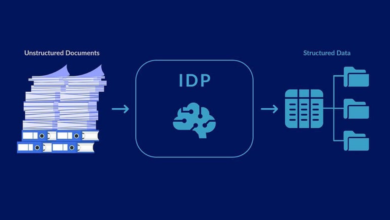
The Ultimate Guide to Understanding Network Architecture: 7 Key Concepts
Introduction
Network architecture is the backbone of modern communication systems, encompassing the design and organization of networks that enable data exchange between devices. Understanding network architecture is crucial for IT professionals, network engineers, and anyone interested in how digital information flows in today’s connected world. This comprehensive guide will delve into the intricacies of network architecture, exploring its components, types, and design principles to provide a holistic understanding of this critical aspect of information technology.
What is Network Architecture?
Network architecture refers to the design and layout of a computer network, outlining how various components such as devices, connections, and protocols are structured to enable efficient communication. It forms the blueprint for building and managing a network, ensuring that data can flow seamlessly between endpoints.
Network architecture is vital for several reasons. It determines the performance, reliability, and security of a network. A well-designed network architecture can support scalability and adaptability, allowing the network to grow and evolve with organizational needs. Conversely, poor network architecture can lead to inefficiencies, vulnerabilities, and costly downtime.
Types of Network Architecture
Understanding the various types of network architecture is essential to selecting the right framework for specific needs. The primary types include:
Client-Server Architecture
Characteristics: In a client-server architecture, a central server provides resources and services to multiple clients. The server handles requests from clients and manages data storage, processing, and security.
Advantages:
- Centralized control and management
- Enhanced security due to centralized administration
- Scalability to accommodate growing client numbers
Disadvantages:
- Single point of failure
- Higher costs for server maintenance
- Potential for server overload under heavy traffic
Use Cases:
- Business applications like email, databases, and file sharing
- Web services and online platforms
Peer-to-Peer Architecture
Characteristics: Peer-to-peer (P2P) architecture distributes tasks across multiple peers, where each peer can act as both a client and a server. This decentralized approach allows direct data sharing between devices without a central server.
Advantages:
- Reduced server costs
- Increased redundancy and fault tolerance
- Direct and faster data transfer
Disadvantages:
- Security risks due to lack of central control
- Potential for inconsistent data management
- Limited scalability
Use Cases:
- File sharing networks (e.g., BitTorrent)
- Decentralized applications (DApps)
Cloud Network Architecture
Characteristics: Cloud network architecture leverages cloud computing resources to provide scalable and flexible network solutions. Resources such as storage, processing power, and applications are delivered over the internet.
Advantages:
- High scalability and flexibility
- Cost-effective with pay-as-you-go models
- Accessibility from anywhere with internet connectivity
Disadvantages:
- Dependence on internet connectivity
- Potential security and privacy concerns
- Possible compliance and regulatory issues
Use Cases:
- Hosting websites and applications
- Data storage and backup solutions
Hybrid Network Architecture
Characteristics: Hybrid network architecture combines elements of client-server, peer-to-peer, and cloud architectures to create a versatile network environment. It leverages the strengths of different architectures to meet diverse needs.
Advantages:
- Flexibility to integrate various network models
- Enhanced reliability and redundancy
- Scalability to support different workloads
Disadvantages:
- Increased complexity in management
- Potential compatibility issues between different components
- Higher implementation costs
Use Cases:
- Enterprises with diverse IT requirements
- Organizations transitioning to cloud solutions
Components of Network Architecture
A robust network architecture comprises several key components, each playing a crucial role in ensuring effective communication and data exchange.
Hardware
Types:
- Routers: Direct data packets between networks
- Switches: Connect devices within a network, allowing communication
- Firewalls: Protect network boundaries by controlling incoming and outgoing traffic
- Servers: Provide resources and services to clients
Software
Types:
- Operating Systems: Manage hardware and software resources
- Network Management Tools: Monitor and control network performance
- Security Software: Protect network integrity and data privacy
Protocols
Examples:
- TCP/IP: Fundamental protocol suite for internet communication
- HTTP/HTTPS: Protocols for web data transfer
- FTP: Protocol for file transfers
Media
Types:
- Wired Media: Ethernet cables, fiber optics
- Wireless Media: Wi-Fi, Bluetooth
Design Principles of Network Architecture
Designing a network architecture involves several principles that ensure the network’s efficiency, reliability, and security.
Scalability
A scalable network can grow with the organization’s needs without significant reconfiguration or performance loss.
Reliability
Reliability ensures that the network consistently performs well and minimizes downtime, providing uninterrupted service.
Performance
Performance measures the network’s ability to handle data efficiently, ensuring fast and responsive communication.
Security
Security protects the network from threats and vulnerabilities, safeguarding data integrity and privacy.
Manageability
Manageability allows network administrators to monitor, control, and optimize the network effectively.
Network Topologies
Network topology refers to the physical or logical arrangement of network devices and how they communicate with each other. Common topologies include:
Bus Topology
All devices are connected to a single central cable, known as the bus.
Star Topology
Devices are connected to a central hub, which facilitates communication between them.
Ring Topology
Devices are connected in a circular fashion, with each device having two neighbors for communication.
Mesh Topology
Every device is connected to every other device, providing high redundancy and reliability.
Tree Topology
A hybrid topology combining characteristics of star and bus topologies, with hierarchical organization.
Hybrid Topology
Combines multiple topologies to meet specific network requirements.
OSI Model and Network Architecture
The OSI (Open Systems Interconnection) model is a conceptual framework that standardizes network functions into seven layers.
Layers and Functions
- Physical Layer: Transmits raw data over physical medium
- Data Link Layer: Manages data frames between connected devices
- Network Layer: Determines how data is sent to the receiving device
- Transport Layer: Ensures reliable data transfer
- Session Layer: Manages sessions between applications
- Presentation Layer: Translates data formats
- Application Layer: Supports application and end-user processes
For more information visit: uploadarticle.net
Importance
The OSI model helps standardize network design and troubleshooting, ensuring interoperability between different systems and devices.
TCP/IP Model and Network Architecture
The TCP/IP model is a simplified, four-layer framework used for network communication.
Layers and Functions
- Network Interface Layer: Handles physical connection to the network
- Internet Layer: Manages data packet routing
- Transport Layer: Provides reliable data transfer
- Application Layer: Interfaces with software applications
Importance
The TCP/IP model underpins the internet, facilitating communication between diverse networks and ensuring data integrity and delivery.
Routing and Switching in Network Architecture
Routing and switching are fundamental processes in network architecture, enabling data movement within and between networks.
Definitions
- Routing: Directs data packets between different networks
- Switching: Connects devices within a network, allowing data exchange
Types
- Static Routing: Manual route configuration
- Dynamic Routing: Automatic route updates
- Layer 2 Switching: Operates at the data link layer
- Layer 3 Switching: Combines routing and switching functionalities
Importance
Effective routing and switching ensure efficient, reliable, and secure data transfer across networks.
Network Security Architecture
Network security architecture focuses on protecting networks from threats and vulnerabilities.
Threats
- Malware: Malicious software that can damage or disrupt network operations
- Phishing: Deceptive attempts to steal sensitive information
- DDoS Attacks: Overwhelm network resources, causing service disruptions
Solutions
- Firewalls: Control incoming and outgoing traffic
- Intrusion Detection Systems (IDS): Monitor for suspicious activities
- Encryption: Protects data during transmission
Best Practices
- Regularly update software and hardware
- Implement strong authentication measures
- Conduct regular security audits
Wireless Network Architecture
Wireless network architecture eliminates the need for physical cables, providing flexible and mobile connectivity.
Types
- Wi-Fi: Wireless local area network (WLAN) technology
- Bluetooth: Short-range wireless technology
- Cellular Networks: Long-range communication using cell towers
Components
- Access Points: Enable wireless devices to connect to a wired network
- Wireless Controllers: Manage multiple access points
Challenges
- Interference: Signal disruption from other devices
- Security: Protecting against unauthorized access
- Bandwidth Limitations: Managing limited wireless spectrum
Future Trends in Network Architecture
Network architecture is constantly evolving to meet emerging technological demands.
SDN (Software-Defined Networking)
SDN separates network control from the physical infrastructure, allowing more flexible and programmable networks.
NFV (Network Functions Virtualization)
NFV virtualizes network services, reducing the need for dedicated hardware and enhancing scalability.
5G
5G technology promises higher speeds, lower latency, and greater capacity for connected devices.
IoT (Internet of Things)
IoT connects everyday objects to the internet, requiring robust and scalable network architectures.
AI (Artificial Intelligence)
AI can optimize network performance, enhance security, and automate network management tasks.
Case Studies of Network Architecture
Examining real-world examples can provide valuable insights into effective network architecture design.
Example 1: Enterprise Network Upgrade
An enterprise upgraded its network architecture to support remote work, implementing a hybrid model combining cloud and on-premises resources.
Example 2: E-commerce Platform Scalability
An e-commerce platform leveraged cloud network architecture to scale quickly and handle peak traffic during sales events.
Challenges in Network Architecture
Designing and maintaining a network architecture involves several challenges.
Scalability
Ensuring the network can grow without performance degradation.
Security
Protecting against evolving threats and vulnerabilities.
Management
Efficiently managing and monitoring network performance and health.
Best Practices for Designing Network Architecture
Adhering to best practices ensures a robust and efficient network architecture.
Guidelines
- Conduct thorough needs analysis before design
- Choose scalable and flexible components
- Prioritize security at every layer
Tools
- Network simulation and modeling tools
- Monitoring and management software
Strategies
- Regularly review and update network design
- Implement redundancy and failover mechanisms
- Foster collaboration between IT and business units
Frequently Asked Questions (FAQs)
How does network architecture impact performance? Network architecture directly affects data flow efficiency, speed, and reliability, influencing overall network performance.
What is the difference between routing and switching? Routing directs data between different networks, while switching connects devices within the same network.
Why is security important in network architecture? Security protects data integrity, prevents unauthorized access, and ensures network availability.
What are the benefits of cloud network architecture? Cloud network architecture offers scalability, cost-efficiency, and remote accessibility.
How do wireless networks differ from wired networks? Wireless networks use radio waves for communication, providing mobility, while wired networks use physical cables for connections.
What role does the OSI model play in network architecture? The OSI model standardizes network functions into layers, facilitating interoperability and troubleshooting.
Conclusion
Network architecture is a fundamental aspect of modern communication systems, shaping how data is exchanged and managed. By understanding its types, components, and design principles, we can build efficient, reliable, and secure networks that meet evolving technological demands. Whether implementing a client-server model, exploring cloud solutions, or enhancing network security, a well-designed network architecture is crucial for organizational success.




